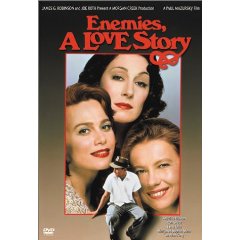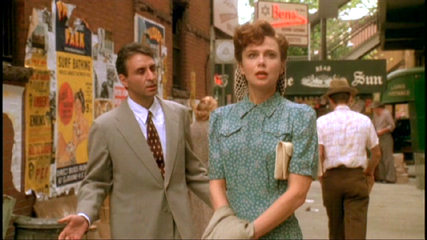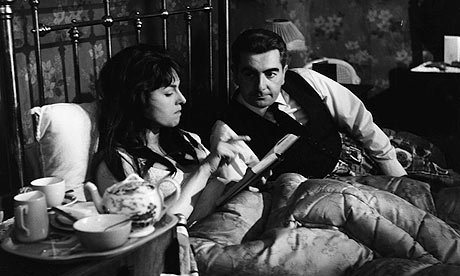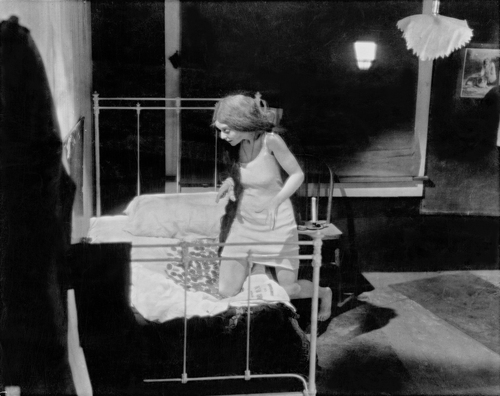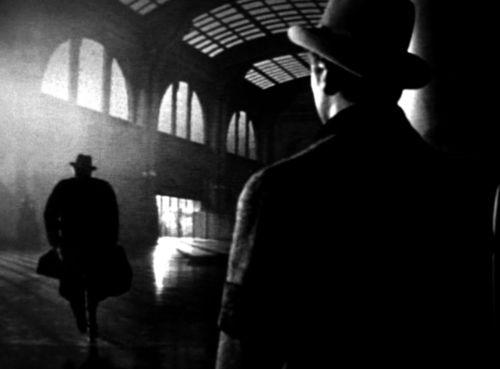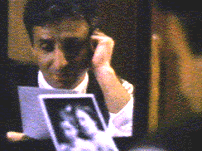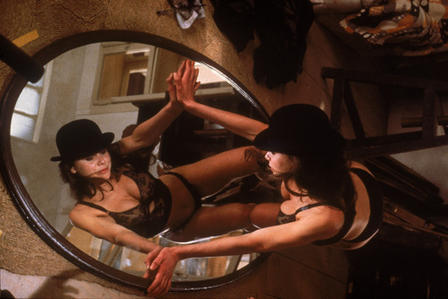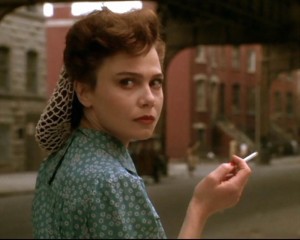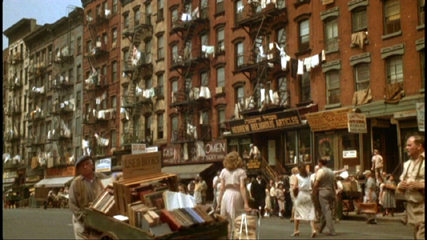From the January 19, 1990 Chicago Reader. –J.R.
ENEMIES, A LOVE STORY
*** (A must-see)
Directed by Paul Mazursky
Written by Roger L. Simon and Mazursky
With Ron Silver, Anjelica Huston, Lena Olin, Margaret Sophie Stein, Alan King, Judith Malina, and Mazursky.
It’s a truism of film criticism that the best movie adaptations of novels usually aren’t taken from the best novels. A good novel, like a good movie, has its own raison d’être, and attempting to translate one person’s novel into another person’s movie usually entails removing the novel’s raison d’etre or at least transmogrifying it beyond recognition. A classic example of misplaced piety, in the sense of a movie trying to follow a novel too closely, is Joseph Strick’s Ulysses (1967): despite the fact that characters, settings, and entire textual passages from Joyce are all dutifully delivered and rendered, Joyce himself is absent from the movie. The personal, historical, and formal determinations of the book have nothing to do with those of the director of the film, working almost half a century later. The gap between Joyce’s reasons for writing Ulysses and Strick’s reasons for adapting it is so cosmically wide that the two sets of motivations aren’t even on speaking terms.
Everybody has his own horror story about his favorite book being massacred at the movies — the history of film is strewn with these stillborn corpses — and the handful of exceptions to this rule often meet their deaths elsewhere: either at the hands of the scissors-wielding studios (I’m thinking of Erich von Stroheim’s Greed and Orson Welles’s The Magnificent Ambersons) or the equally pitiless box office (as in John Huston’s Wise Blood and Bill Forsyth’s Housekeeping).
Still another problem governing adaptations of novels, good or bad, is posed by the issue of which version one encounters first, the book or the movie. When one reads a book one conjures up characters and settings, space and scale, out of the author’s prose, and any movie replacements of these images are bound to register as interferences. Conversely, seeing a movie before you read the novel can easily impair your first encounter with the author’s prose by allowing its images to supplant or forestall your own. Either way, something is lost as well as gained, and the first version that one encounters tends to dominate one’s responses.
To make matters worse, good adaptations usually compound this problem. As a teenager, I saw the horrific Hollywood versions of The Sound and the Fury and Miss Lonelyhearts shortly before I read the novels, and though ludicrous memories of Yul Brynner’s Jason Compson and Robert Ryan’s Shrike hovered over my initial experiences of those books, the power of Faulkner’s and West’s writing eventually buried them. No such effacement took place, however, when I read Frank Norris’s McTeague after seeing Stroheim’s Greed, or when I encountered Booth Tarkington’s Ambersons after meeting the same family in Welles’s movie: the casting was too sensitive and precise, and both films had a personal urgency that wound up influencing and spilling over into my readings of Norris and Tarkington.
I’m certainly not trying to imply that Paul Mazursky, the director and coadapter (with Roger L. Simon) of Isaac Bashevis Singer’s Enemies, a Love Story, belongs in the same league — or even on the same planet — as Stroheim or Welles. I can’t even say that prior to Enemies (the movie) I’ve been any sort of Mazursky fan at all. At best an entertaining comic writer-director, at worst a vulgar propagandist who promotes the worst habits of the American middle class in the name of middlebrow sociology, he is the sort of filmmaker who winds up mauling his own beloved European models — Truffaut’s Jules and Jim in the cutesy Willie and Phil, Renoir’s Boudu Saved From Drowning in the garish Down and Out in Beverly Hills — by removing their subversive sting in the process of “remaking” them.
For all of Mazursky’s deftness with actors — which usually registers more effectively with nonstarring actresses (such as Ellen Burstyn in Harry and Tonto and Shelley Winters in Next Stop, Greenwich Village) than with his male leads (such as Art Carney and Lenny Baker, respectively, in the same films) — the broadness of his directorial style is usually matched only by the narrowness and flatness of his understanding of anything that doesn’t fall squarely within bourgeois norms. This hasn’t prevented him, of course, from milking a voyeuristic and often hypocritical fascination with “deviance” — wife-swapping in Bob & Carol & Ted & Alice, bohemian life in Next Stop, Greenwich Village, feminism in An Unmarried Woman, voluntary homelessness in Down and Out in Beverly Hills, and so on — for bourgeois delectation. In An Unmarried Woman, Mazursky’s perception of the life of an artist (Alan Bates) — executing a painting, eating breakfast, and making love all at the same time — is just how his middle-class audience thinks of artists; that it has little to do with the way a painter might actually paint seems almost beside the point.
I should confess that I’ve never quite forgiven Mazursky for a statement he made several years ago; I haven’t been able to trace it, but I can remember it well enough to paraphrase: “I defend the American middle class because no one else does.” No one else? The implication, somehow, was that everyone else in Hollywood was mounting radical critiques of the status quo while he, brave nonconformist, was going out on a limb in favor of middle-class squares.
All of which, to get finally to my point, left me totally unprepared for Enemies, a Love Story — an emotionally complex story about holocaust survivors in New York City with much of the humor but virtually none of the glibness that I’ve found in Mazursky’s previous work. It also happens to be his first real adaptation, which accounts for much of the difference. Most of the leading characters happen to be middle-class, and Mazursky certainly “defends” them, but for once these two facts seem coincidental rather than merely ideological: one never feels that Mazursky is defending them simply because they’re middle-class. And they’re mainly Eastern Europeans still living through the aftereffects of the holocaust, which makes them far from typical.
At the beginning of the film, after cheerful Jewish folk music plays behind the credits, we hear barking dogs and angry male voices; from the inside of a barn, we see the doors open and soldiers enter with the dogs, the camera quickly gliding past the grisly flayed head of a cow carcass. What turns out to be a nightmare/memory ends with a maid (Margaret Sophie Stein) screaming. The hero, Herman (Ron Silver), wakes up and looks out the window at a ferris wheel; a title informs us that it’s Coney Island in 1949.
Herman, we soon learn, is now married to Yadwiga, the girl in his dream. A non-Jew, she was his maid in Poland and she saved his life, caring for him while he hid from the Nazis in a hayloft; she now happily waits on him hand and foot. We also learn that Herman habitually lies to her — he’s a speech ghostwriter for a wealthy Manhattan rabbi (Alan King), but he tells her he’s a traveling book salesman, which enables him to carry on a passionate affair with another Jewish holocaust survivor, Masha (Lena Olin), who lives with her mother (Judith Malina) in the Bronx. Separated from her own husband (Mazursky), Masha is jealous of Herman’s marriage to Yadwiga, and hopes to marry him as soon as she can secure a divorce.
The plot thickens when Herman discovers that his first wife, Tamara (Anjelica Huston), who he had heard was killed along with their two children by the Nazis, is now alive and well in Manhattan. When they meet and Tamara learns of his marriage to Yadwiga, she makes no demands about resuming their own marriage, but serves Herman as a friend and occasional lover (as well as adviser after she learns about Masha). Eventually Herman finds himself married to all three women, a trigamist.
These sexual dynamics suggest male chauvinism with a vengeance, but it’s part of the wit, beauty, and power of the story that indecisive Herman, while remaining sympathetic, steadily shrinks in his stature as a character while the wives correspondingly grow in strength and capability. Most surprising of all, while virtually all of the story is told from Herman’s viewpoint, he vanishes from the plot by the final scene, and he clearly isn’t missed by either the other remaining characters — all female — or by the audience.
I won’t recount any of the movie’s remaining plot — which is fairly intricate, often comic, and informed by tragic events and overtones that are scarcely suggested in the preceding summary — but I would like to bring up Singer’s novel, which I read after seeing the film for the first time, and which, for obvious reasons, I find difficult to evaluate apart from Mazursky’s movie. I should add that seeing the movie a second time made me more aware of Mazursky’s strengths (which mainly, if not exclusively, have to do with his overall fidelity to Singer) as well as his limitations (which mainly, if not exclusively, have to do with resemblances between Enemies and earlier Mazursky movies).
Concerning Mazursky’s strengths, the movie has uncommonly good dialogue and nearly all of it derives directly or indirectly from Singer, either through direct quotation or paraphrase. The performances of the leads are more than just good; in the cases of Silver, Huston, and Stein, they’re downright incandescent. If I omit the volatile Olin from this honor roll, this is chiefly because she doesn’t quite bring off a climactic scene involving hysterical screams, but candor compels me to admit that she more than makes up for this lapse elsewhere; her final scene, which concentrates and expands everything we know about her character, is played to perfection. Mazursky’s own single scene is both rich and restrained — a judiciously shaped cameo.)
The period re-creations of Coney Island, Manhattan, and the Bronx are superb without being ostentatious — a rare virtue in contemporary movies. A convenient counterexample would be Driving Miss Daisy, set in Atlanta between the late 40s and the early 70s. Having seen both New York and Atlanta as a child in the early 50s, I can testify that there’s no question which of these two modestly budgeted pictures actually evokes its elected period and setting. Driving Miss Daisy‘s sketchy stab at Atlanta strains visibly for accuracy and comes out feeling wrong; Enemies‘s New York is precisely the place that I remember. The fact that the former was directed by an Australian while the latter was directed by a New Yorker — born in Brooklyn in 1930 — surely accounts for much of the difference.
A good deal of Simon and Mazursky’s adaptation goes beyond a simple translation of descriptions into images by condensing Singer’s world and time frame in a number of ways. The use of a Coney Island subway station where we often see Herman, with separate signs for trains going to Manhattan and the Bronx, graphically illustrates the pattern and dilemma of his life with an immediacy that is less available to prose. The decision to do without flashbacks and to minimize Herman’s dreams, memories, and fantasies about Nazis undoubtedly reduces our sense of the central characters and their pasts — with implications that I’ll get to shortly — although the film manages to be fairly resourceful, using aural or visual shorthand to suggest at least part of what it omits: the sound of barking dogs to represent Herman’s recurring memories and fear of Nazis, his fleeting fantasy of seeing Nazis in a subway car, a close-up of the serial number tattooed on Masha’s forearm that introduces us to her character (which comes at the beginning of a gracefully extended long take charting Herman’s arrival at her apartment).
The question of how to represent the holocaust in contemporary cinema can basically be addressed in two possible ways, which might be termed pre-Shoah and post-Shoah approaches. A major part of what makes Claude Lanzmann’s Shoah a watershed in relation to this issue is its assertion that the holocaust can’t be visualized — that is, represented literally. Lanzmann’s method was to convey through interviews as much concrete data as possible and to leave the visualization of the events up to the viewer’s imagination, furnishing only meditative views of the routes to the death camps and the sites of the camps today as figurative blackboards on which we must draw our own images.
A good example of pre-Shoah tactics is the way Costa-Gavras’s current Music Box bandies about telltale photographs of Nazi brutalities. On the other hand, when it shows its heroine contemplating the Danube and imagining the atrocities that occurred there — a contrived scene that actually works against any impulse on the part of the viewer to do the same thing — the film vulgarizes, sentimentalizes, and falsifies Lanzmann’s approach. By contrast, Enemies is post-Shoah insofar as the holocaust is resolutely kept offscreen (discounting Herman’s fleeting and wholly subjective nightmare and subway fantasy); it provides the subtext of most of what we see and the context of much of what we hear in the dialogue, but it’s not treated by the film as an event that can be objectively represented in visual terms.
The consequences of this reticence are fundamental to the film’s beauty and power because they amount to a form of respect for both the real victims of the holocaust and the viewer’s capacity to imagine their experiences. (An ironic form of the same respect is expressed in the first sentence of Singer’s author’s note preceding the novel: “Although I did not have the privilege of going through the Hitler holocaust, I have lived for years in New York with refugees from this ordeal.”)
On the other hand, Mazursky’s approach deprives us of certain important aspects of the characters found in the novel, such as Herman’s paranoid revenge fantasies and Tamara’s past as a political activist — specifically, as a communist and a Zionist. The pasts and personalities of Herman, Masha, Tamara, and Yadwiga become abbreviated through these omissions, and even though one can readily understand (if not condone) the filmmakers’ reasons for eliding this material, someone who reads the novel first is much likelier to have problems with the film.
More defensible, perhaps, are Mazursky’s efforts to broaden and embellish some of the novel’s farcical possibilities. When Herman and Masha are vacationing in the Catskills, the movie provides the comic complications of Tamara’s uncle and aunt (who know nothing about Masha) vacationing at the same resort — the sort of coincidence that is routine for a Mazursky comedy, if a mite less congruent with Singer’s own form of plotting. Similarly, Mazursky allows Alan King, as the rabbi Herman works for, to become needlessly hammy in his first scene, and stages a confrontation between Masha and Herman at the rabbi’s party as a raucous public event heard by all the guests, not the smaller private event that it is in the novel.
Obviously Mazursky isn’t Singer, and it seems reasonable enough that he should introduce some of his own shtick from time to time to make the movie more his own — although I’m grateful that he didn’t go overboard in this regard. (On the other hand, perhaps his most radical and important deviation from Singer consists of what he does to alter and dramatize the novel’s epilogue in his remarkable final scene, which to my mind improves on the original.) The marvel of Enemies, a Love Story is that he has managed to subdue most of his own worst habits and discipline his finer gifts to get as much as he can out of a luminous novel — which proves to be quite a bit, and plenty to be grateful for.

